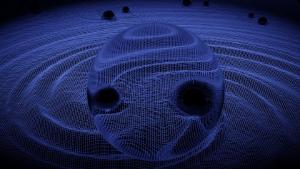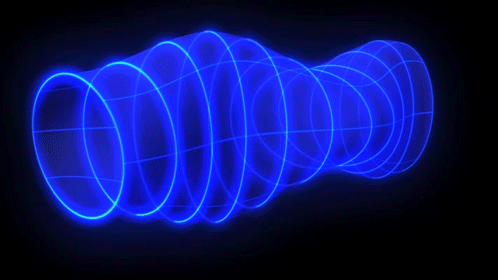Blog
Waving the Wave
23 May 2021
 Riccardo Buscicchio (University of Birmingham)
Riccardo Buscicchio (University of Birmingham)Gravitational-wave astronomy is very different from that of electromagnetic light. While gravitational waves are faint and difficult to detect, they also pass through matter with little effect. In essence, the material universe is transparent to gravitational waves. This makes gravitational wave astronomy a powerful tool when studying the universe. But it’s still in the early stages, and there is much to learn about how gravitational waves behave.
Take, for example, gravitational lensing. It occurs when light from a distant object such as a quasar is deflected slightly as it passes near a galaxy or other massive object. The gravitational curvature created by the galaxy’s mass acts as a lens, which can focus the quasar light and produce multiple quasar images. This effect occurs because light travels through space and time, so when spacetime is warped, so is the path of light.
 ESA–C.Carreau
ESA–C.CarreauBut gravitational waves are different. Rather than photons traveling through space, gravitational waves are ripple of spacetime in spacetime. So can they be deflected or lensed similar to light? Einstein’s theory of relativity predicts they can be. A warping of space changes the way gravitational waves propagate, so they are also deflected. This effect has never been observed, but a new study has combed LIGO and Virgo data looking for it.1
The team looked for several effects of gravitation lensing on the black hole merger signals detected by LIGO and Virgo, such as identical mergers coming from slightly different sources, or an interference pattern in gravitational waves that would be caused by two images of the merger reaching Earth at slightly different times.
In the latest data run containing 36 merger events, the team found no evidence of lensed gravitational waves. That’s not too surprising, given the sample size. But the team has shown it is possible given current technology. As new gravitational wave observatories such as LISA are built, lensed gravitational waves will either be detected, or we will have to re-examine Einstein’s theory.
This kind of study has tremendous potential to enhance our understanding of the universe. Currently, the gravitational lensing of light lets us see more distant objects than we would otherwise, and lets us measure aspects of cosmology such as the expansion of the universe. But light can be obscured or dimmed by diffuse gas and dust between galaxies. Gravitational waves aren’t limited in this way, so gravitational lensing could allow us to make precise measurements of cosmology. It could also test Einstein’s theory in new and subtle ways. General relativity has passed all the tests so far, but new and interesting physics could be waiting to be discovered.
Abbott, R., et al. “Search for lensing signatures in the gravitational-wave observations from the first half of LIGO-Virgo’s third observing run.” arXiv preprint arXiv:2105.06384 (2021). ↩︎